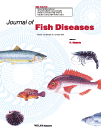Monitoring fish welfare using heart rate bio-loggers in farmed Atlantic salmon (Salmo salar L.): An insight into the surgical recovery

Abstract
Atlantic salmon are one of most studied cultured species, still continuous fish welfare monitoring is a challenge during commercial farming operations. Although, mortality is the terminal indicator of fish welfare, but without further explanation, this parameter is of limited use. Fish welfare on-site can be monitored by using implantable DST milli-HRT bio-loggers that record heart rate, electrocardiography and temperature. These heart rate loggers gave us the opportunity to monitor fish welfare under common farm handlings in free-swimming farmed Atlantic salmon (~1 kg). Three different stress tests such as crowding (test 1), grading (test 2) & vaccination (test 3) were performed on three separate fish groups three weeks post-surgery. Heart rate and biochemical parameters (blood plasma and mucous) including cortisol were measured and compared in pre-stressed (T0), stressed (T1) and post-stressed (T48) fish. A modified loggers anchoring technique was used where two separate thin sutures were threaded at front hole of the logger and knot them through the skin/muscle for anchoring as it improved the fish welfare during surgery. Surgical wound showed complete skin/peritoneal apposition with regenerated skeletal muscle, fibrosis, lymphocyte-like cells and vascularization at the site three weeks post-surgery. Following surgery, heart rate (fH) was elevated (˃70 beats min−1) which stabilized 3 days post-surgery in tests 1 & 3. However, it took at least 10 days to stabilize fH in case of test 2. All three stress tests inflicted tachycardia suggesting aquaculture practices incur stress in farmed Atlantic salmon. Heart rate was raised at stress (range 62–78 beats min−1) as compared to pre-stress levels (range 44–48 beats min−1) that corresponds to 42–77% elevation in all three tests. Cortisol levels were upregulated following tests but only significantly different in test 3. This study reveals that physiological responses (heart rate) should be combined with histological evaluation of surgical healing before utilizing the heart rate (fH) data. Upon handling, fish should be given enough time (˃48 h) to stabilize fH levels before commencing to other tests/handlings. In conclusion, heart rate can be used for continuous fish welfare monitoring under farming conditions.
